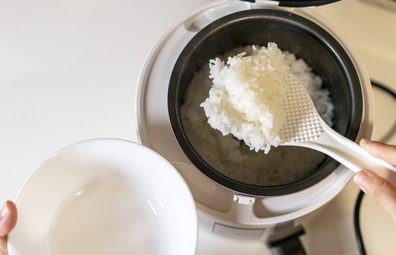Forget the days in which rice was white, and the only decision you had to make at the supermarket was whether you wanted a big or massive packet added to your grocery shop.
Nowadays not only do we have many different varieties of rice readily available, but also a range of different cooking options so you will find rice in cups, pouches and blends with other grains.
So, for all the rice lovers out there it is time to sort out the brown from the wild to the black and everything in between so that you can make the best choice nutritionally for you and your dietary goals.
READ MORE: The difference between dairy and plant-based milks

White rice
Even when it comes to white rice there are plenty of different options. Now you can find short-grain, arborio, medium grain and long grain varieties of white rice in both quick cook and traditional, longer cook options. White rice remains the most common type of rice, but nutritionally it is not the best choice. Processed in a way to have much of the wholegrain component removed, white rice is lower in protein, dietary fibre and essential nutrients compared to wholegrain brown rice. As a heavily refined grain, white rice also has a relatively high glycaemic index, resulting in relatively high blood glucose levels after eating.
Specifically, the shorter grain white rices include sushi rice, and arborio rice commonly used to make risotto. Shorter grain rices have a higher GI than longer grain white rices, and can even become sweet when cooked which is why they are also used to make desserts in some cultures. Medium grain white rice is the variety most commonly served with Asian cuisine and has a relatively high GI.
In addition to short and medium-grain white rice, there is also long grain rice which includes both basmati and jasmine rice. At times referred to as ‘healthier’ options, long grain rice does have a lower GI than short grain rice but still lacks the nutritional density of wholegrain brown rice.
READ MORE: Simple swaps to double your nutrient intake

Brown rice
The popularity of wholegrain brown rice has risen exponentially in Australia in recent years and is now a popular option in quick cook varieties as well as on Japanese menus. A medium grain rice, brown rice is made from more of the wholegrain, meaning it is higher in both dietary fibre and protein as well as key nutrients including iron, Vitamin B and magnesium. With its slightly nutty taste and chewy texture, brown rice is a healthier alternative to white rice as a daily addition is salads, stir fries and sushi.
READ MORE: How to take control of your salty and sweet cravings

Black rice
Sometimes referred to as purple rice, black rice is a nutrient rich, wholegrain rice and contains the antioxidant anthocyanin which gives the rice a deep colour when cooked. Rich in iron and Vitamin E, black rice is more nutritious than white rice, and contains slightly more protein than brown rice making it an especially filling option. With its nutty flavour black rice works well with salads as well as in puddings and desserts.
Red rice
While not as common in Australia, red rice is a wholegrain rice which also retains its rich colour thanks to the antioxidant anthocyanin. With a rich nutty flavour, red rice is extremely nutritious thanks to its high fibre content and versatile, making a great addition to any rice mix or flavoursome salad.
Wild rice
Significantly higher in protein than other types of rice, wild rice is technically a type of grass not rice. Up to 30 per cent lower in calories it is rich in a number of key nutrients including magnesium, zinc and Vitamin B. Although more expensive, wild rice is a great choice nutritionally and can easily be enjoyed mixed with other rice varieties or enjoyed as a base to salad.
For a daily dose of 9Honey, subscribe to our newsletter here
Author Susie Burrell is a leading Australian dietitian and nutritionist, founder of Shape Me, co-host of The Nutrition Couch podcast and prominent media spokesperson, with regular appearances in both print and television media commenting on all areas of diet, weight loss and nutrition.
